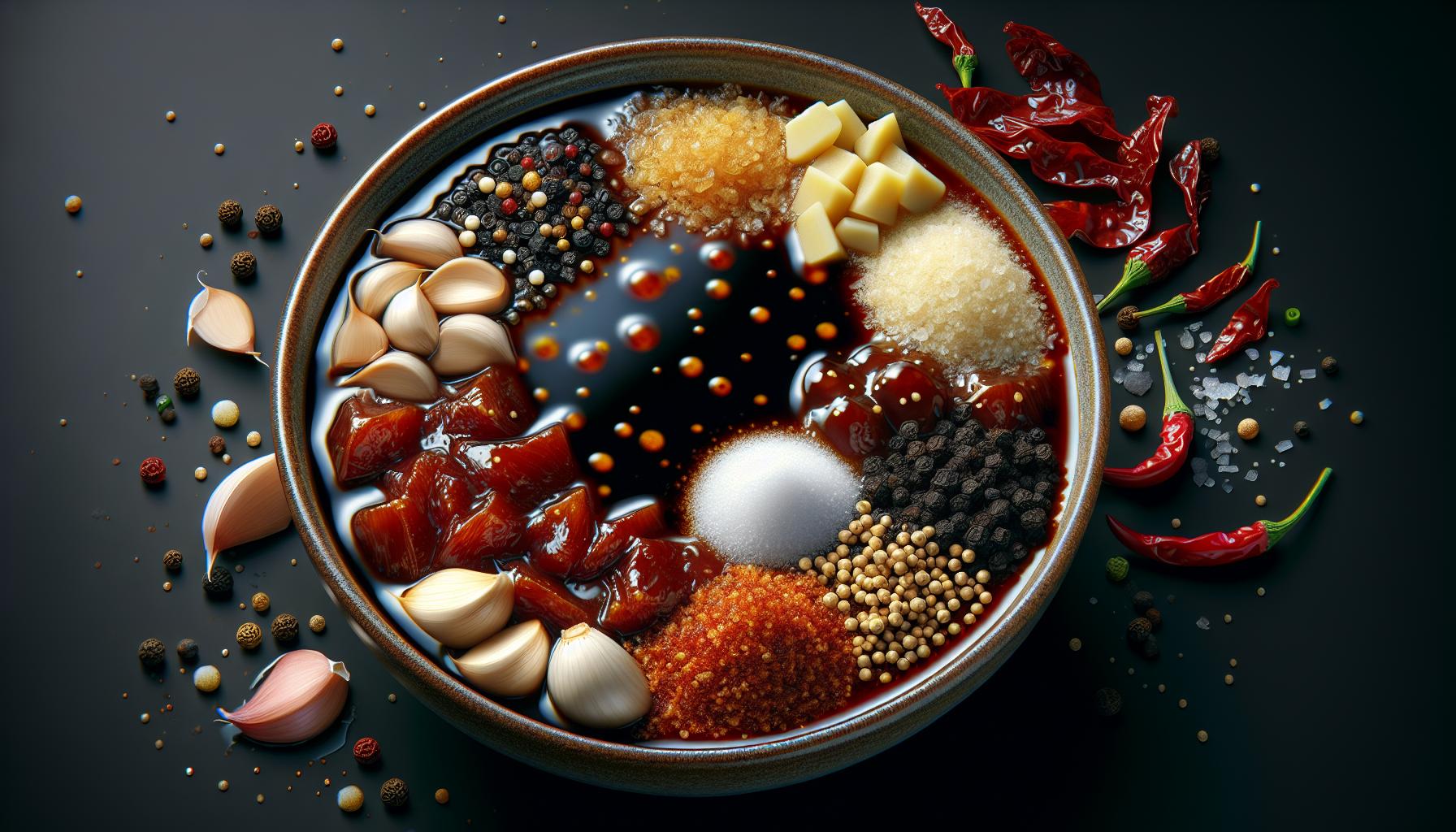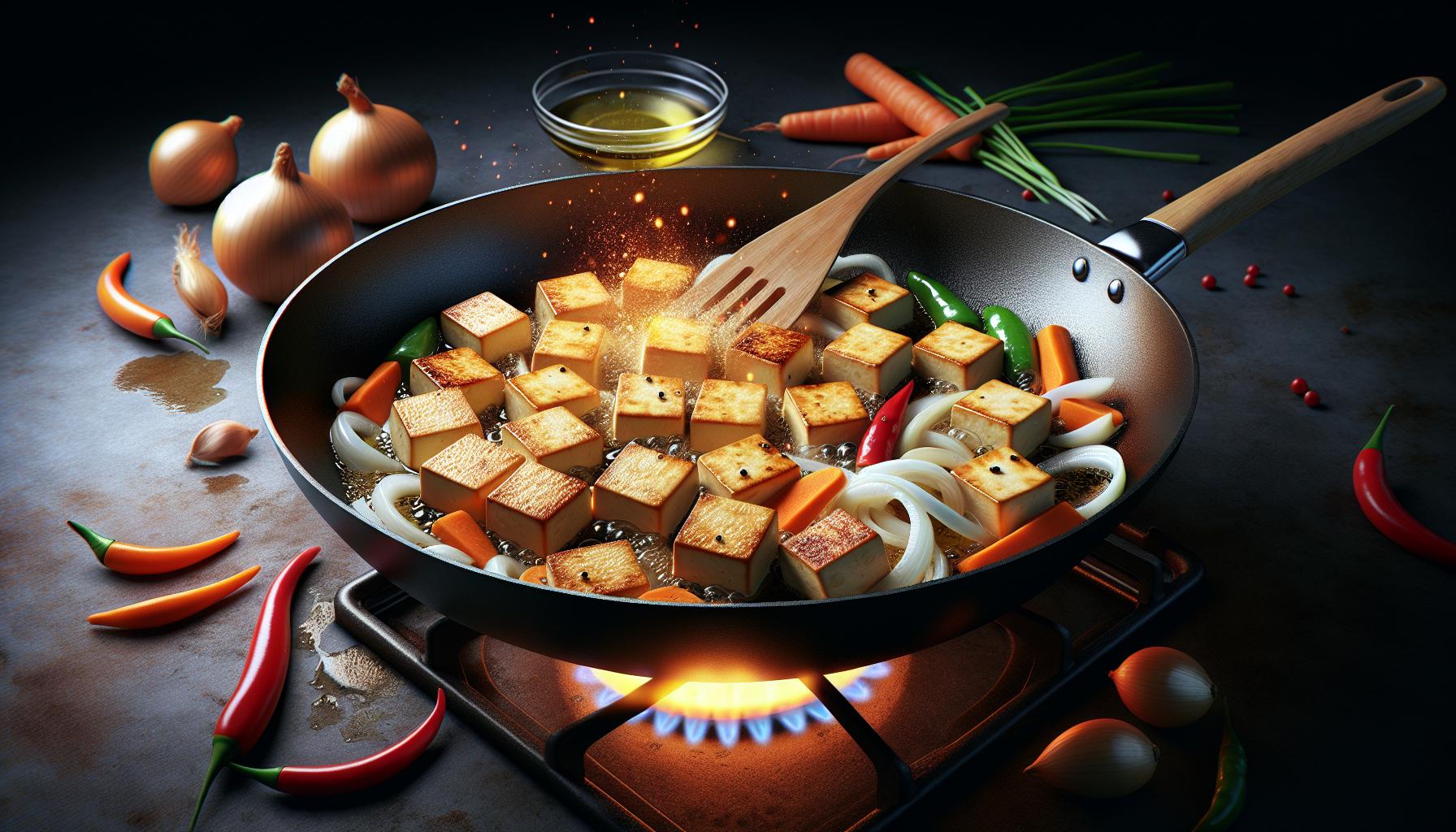Choosing the right tofu
It’s crucial to select an optimal type of tofu for Dubu Jorim. Your choice of tofu is quite essential in cooking this exceptional Korean braised tofu dish.
There are various types of tofu readily available in supermarkets. The difference in each type lies in the water content. This fact greatly impacts the tofu’s texture and sponginess. Firm and extra firm tofu are excellent choices for our Dubu Jorim recipe.
Firm Tofu
Firm tofu, with a robust texture and high protein content, is popular among health-enthusiasts. When braised, it absorbs flavors beautifully but maintains its solid form, making it a fabulous choice for our savory delight.
Extra Firm Tofu
An alternate is the extra firm tofu. With an even higher protein content and a solid texture, this tofu variant doesn’t crumble easily under heat. You’re sure to appreciate its ability to withstand longer cooking durations should you be keen on a heartier braise.
Hold on, got allergies or following a specific diet? Don’t fret, as there’s always an alternative! For those allergic to soy, you can opt for almond or chickpea tofu available in health food stores. If you’re on a keto diet, the extra firm tofu is the way to go – low in carbs, high in protein.
Thinking from an eco-friendly perspective, we recommend organic tofu. It’s free of GMOs and produced with environmental considerations.
Let’s see the nutrient profile of each to help you make an enlightened choice!
| Type of Tofu | Calories | Protein | Fat | Carbs |
|---|---|---|---|---|
| Firm Tofu (100g) | 144 | 15g | 8g | 4g |
| Extra Firm Tofu (100g) | 183 | 20g | 10g | 5g |
| Almond Tofu (100g) | 480 | 12g | 20g | 10g |
| Chickpea Tofu (100g) | 144 | 8g | 6g | 16g |
Preparing the tofu for braising
Preparing tofu for Dubu Jorim isn’t complicated but there are some tricks to keep things running smoothly. The first important step in the process is draining the tofu. You’ll find it in water-packed containers and getting excess water out is key to get a firm texture. There’s a simple way to do this: leave the tofu in between a stack of paper towels and stack a heavy pot or pan on top. The weight will slowly compress the tofu, squeezing out the water. Let it sit for about 15-20 minutes. This will ensure that our tofu is well-prepared for braising.
With your tofu drained, you’re halfway to a perfect batch of braised tofu. The next step is to cut your tofu into bite-sized pieces. For a more traditional dubu jorim, you could cut the tofu block into 10 slices, each about half an inch thick.
Here’s where this recipe shines. You might not typically find this in traditional recipes, but lightly pan-frying the tofu before braising can truly elevate your dish and make it unforgettable. Just a splash of oil in the pan, add the tofu, and pan-fry both sides for 2-3 minutes until golden. This extra step is what gives the tofu a fantastic piquancy and the beautiful golden hue you’re after.
It’s also important to remember your tofu’s nutrient profile. In the spirit of maintaining its high protein content during braising, careful not to overcook it. Below is a table representing the nutrient content of 100g of braised tofu.
| Nutrient | Quantity |
|---|---|
| Calories | 144kcal |
| Protein | 15.3g |
| Fats | 8g |
| Carbohydrates | 3.9g |
| Fiber | 1.1g |
Free to play around with different alternatives if you’re on a non-soy diet. You could try almond or chickpea tofu – these alternatives work just as fine and they bring their own subtle flavor profiles. For those sticking to a keto diet, extra-firm tofu’s your go-to. Remember to opt for the organic variety if possible – your environment and body will thank you.
Making the braising sauce

Creating a flavorsome braising sauce is vital to the overall taste of your Dubu Jorim. This sauce will encapsulate your tofu, transforming its original mellow flavor into a confident finish of sweet, salty, and subtle heat.
Start by mincing garlic and grating ginger, aromatic ingredients that lay the foundation for your sauce. You’ll need about three cloves of garlic and about a teaspoon of fresh ginger.
| Ingredient | Amount |
|---|---|
| Garlic | 3 cloves |
| Ginger | 1 teaspoon |
Then, mix your soy sauce, sesame oil, sugar, and Korean red pepper flakes in a bowl. The container acts as a vessel for these flavors to marry each other:
| Ingredient | Amount |
|---|---|
| Soy Sauce | 1/4 Cup |
| Sesame oil | 2 Tablespoons |
| Sugar | 1 Tablespoon |
| Korean Red Pepper Flakes | 1 Teaspoon |
Don’t worry if Korean red pepper flakes are tricky to find in your local grocery store. A blend of mild paprika and cayenne pepper makes an effective substitute. It’s all about making use of what’s available in your pantry!
Add in the minced garlic and grated ginger to your sauce mix. Finally, pour in around a cup of water. This dilutes the sauce and primes it for the braising process.
| Ingredient | Amount |
|---|---|
| Water | 1 cup |
Stir well to ensure that your sugar is properly dissolved. Also, it guarantees that the flavors are well distributed throughout the sauce. This ensures every bite of your tofu is evenly seasoned.
Magically, your braising sauce is ready! Remember that the key to a perfect Dubu Jorim dish lies in the balance of flavors. So, feel free to adjust the sugar or the heat level in the mixture to match your personal preferences.
Alter the sauce to suit your dietary needs too. If you’re on a low-sodium diet, consider a splash of coconut aminos instead of soy sauce. Or, swap out typical sugar with coconut sugar for a balanced sweetness with a slight hint of caramel-like flavour.
Braising the tofu

Following the creation of your flavor-packed sauce, it’s time to bring the tofu into the equation. Preferably using extra-firm tofu, slice it into cubes of approximately 1 inch in thickness. This size is perfect for achieving a fantastic texture – crispy on the outside yet tender on the inside.
Now it’s time to prep the tofu. Heat a non-stick skillet with a splash of neutral oil (like canola or grape seed), ensuring the pan is hot but not smoking. Place the tofu cubes in the skillet, allowing them to sear until they develop a golden crust. Flip them over until each side is nicely browned. The result should be tofu that’s nice and crispy without being overly hard.
Here’s a little tip that could elevate your Dubu Jorim to new heights: some cooks like to marinate the tofu in the braising sauce for approximately 10 to 15 minutes. Doing this can deepen the flavors, driving them right into the heart of the tofu cubes.
Next up, let’s prepare the vegetables. An authentic Dubu Jorim often uses carrots and onions. Slice them thinly so they cook quickly while keeping their vibrant colors. And, for a touch of heat, consider adding some sliced fresh chillies to the mix.
Got the veggies prepped? Great! Now add your tofu, the prepared vegetables, and the braising sauce into the skillet. Make sure everything is evenly coated in the sauce before covering the skillet. Let it simmer for around 10 minutes, allowing the sauce to reduce and the flavors to meld together.
And there you have it. By following these steps, you are guaranteed to make a flavorful Dubu Jorim that is true to its Korean roots but also attuned to your taste buds.
Remember – every step in the cooking process contributes to the final flavor profile of your dish. So, consider each ingredient and technique as an essential component in creating this delightfully comforting and hearty dish. Enjoy the process.
Serving and garnishing tips
Serving your homemade Dubu Jorim isn’t just about the taste. It’s about creating an experience that’s memorable and special. Garnishing plays a key role here. To elevate the visual appeal and add a punch to the flavors, you need to choose your garnishes well.
Green onions and sesame seeds are a classic choice that never goes out of style. Chop green onions finely and sprinkle generously over your dish. Add a dash of toasted sesame seeds, they bring a crunchy texture and nutty flavor. And oh, don’t miss out on the sesame oil. A little drizzle does wonders, it gives a rich depth to the Kalbi marinade base of the Dubu Jorim.
For those who prefer a spicy kick, there’s always the fiery Korean red pepper (Gochugaru). It’s not just about the heat, Gochugaru brings a sweet, smoky and slightly fruity taste that’s irreplaceable. However, if you can’t handle the spice or if it is not readily available, feel free to switch it up with a sprinkle of paprika. It’ll give a brilliant color without setting your tongue on fire.
Love intricate detailing but hate the time it takes? A beautiful garnish doesn’t always need to be time-consuming. Try thinly sliced lemon wheels or cucumber ribbons. They are easy to make, add a fresh tangy touch, and make your dish look like it’s straight out of a gourmet kitchen.
Another lesser-known but interesting twist is to use microgreens. They’re tiny, but their robust and distinct flavors impresses. Micro cilantro or basil can add a splash of color and a surprising twist to the flavor.
Conclusion
So you’ve mastered the art of making homemade Dubu Jorim, Korean braised tofu. You’ve learned how garnishing isn’t just for show – it’s a crucial element that can take your dish to the next level. With the right garnishes like green onions, sesame seeds, and sesame oil, you’re not just adding color and texture, but also enhancing flavor. Don’t shy away from experimenting with a spicy kick from Korean red pepper or paprika. Remember, even simple garnishes like lemon wheels, cucumber ribbons, and microgreens can make a big difference. Now that you’re equipped with this knowledge, your homemade Dubu Jorim is sure to impress. Happy cooking!
